Jennifer Scoullar's Blog, page 10
May 16, 2015
Happy Endangered Species Day!
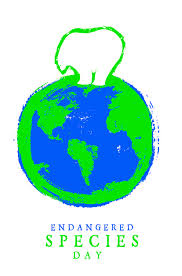 Last Friday was international Endangered Species Day, designed to highlight the plight of many at-risk and critically endangered plants and animals. They are disappearing between 1,000 to 10,000 times the natural rate – with dozens going extinct every day. Over 40% of the world’s species are estimated to be at risk of extinction, primarily from human activities driving habitat loss, introduction of exotic species and global warming.
Last Friday was international Endangered Species Day, designed to highlight the plight of many at-risk and critically endangered plants and animals. They are disappearing between 1,000 to 10,000 times the natural rate – with dozens going extinct every day. Over 40% of the world’s species are estimated to be at risk of extinction, primarily from human activities driving habitat loss, introduction of exotic species and global warming.
Australia is far from immune. In fact it is facing an extinction crisis, with the worst mammal extinction rate in the world: 30 native mammals have become extinct since European settlement. To put this in a global context, 1 out of 3 mammal extinctions in the last 400 years have occurred in Australia.
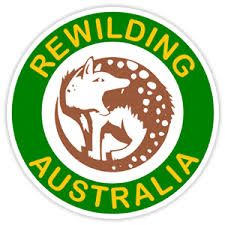 I love to write about our unique wildlife, and the people who fight to protect these birds and animals. My current work-in-progress explores the concept of rewilding. Rewilding means restoring habitats to their original condition (as much as possible) and reintroducing animals and plants that are locally extinct.
I love to write about our unique wildlife, and the people who fight to protect these birds and animals. My current work-in-progress explores the concept of rewilding. Rewilding means restoring habitats to their original condition (as much as possible) and reintroducing animals and plants that are locally extinct.
Rewilding Australia is a registered charity that supports the reintroduction of our apex species like devils and quolls. With the re-establishment of these predator species, combined with a range of large-scale fox and cat control programs, our other smaller 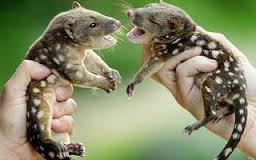 mammals may then be able to survive. Farmers and community organisations from all around Australia are embracing this vision and pitching in to help. Some examples include predator-proof fencing, breeding programs and protecting wildlife corridors. Click here to read a story on an exciting quoll rewilding project.
mammals may then be able to survive. Farmers and community organisations from all around Australia are embracing this vision and pitching in to help. Some examples include predator-proof fencing, breeding programs and protecting wildlife corridors. Click here to read a story on an exciting quoll rewilding project.
I’m excited about the concept of not only conserving, but of actively rebuilding eco-systems. It has also given me the idea for my new book. I’m sure the challenges involved will make for some dramatic story-telling!

May 10, 2015
Dingo Creek Rainforest Nursery
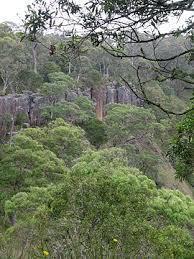 I’m on a research trip, immersing myself in the beauty of the Manning Valley, a few hours drive north of Sydney. This area offers a breath-taking combination of rivers, rainforests, mountains and beaches. Its lush landscapes and national parks will provide a stunning setting for my new book. Aussie author Di Morrissey was born in Wingham, and she still lives in the valley. It became the title and setting for one of her bestselling books.(The Valley Pan Macmillan 2007)
I’m on a research trip, immersing myself in the beauty of the Manning Valley, a few hours drive north of Sydney. This area offers a breath-taking combination of rivers, rainforests, mountains and beaches. Its lush landscapes and national parks will provide a stunning setting for my new book. Aussie author Di Morrissey was born in Wingham, and she still lives in the valley. It became the title and setting for one of her bestselling books.(The Valley Pan Macmillan 2007)
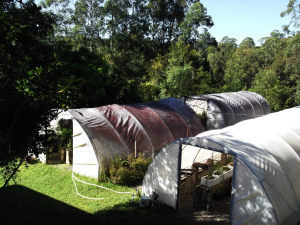 I’ve been staying with an old school friend, Kim Gollan, who lives at Bobin, about an hour’s drive east of Tapin Tops National Park. Kim and her husband Pete run the magnificent forty hectare Dingo Creek Rainforest Nursery. They mainly grow plants endemic to the mid north coast of NSW, in order to conserve these species and make them available to home gardeners, farmers and restoration schemes. For example, they have provided thousands of plants for the Lord Howe Island World Heritage project, and the Manning Valley lowland flood-plain rainforests regeneration plan. They are also caretakers of Wingham Brush and Coocumbac Island (see previous post)
I’ve been staying with an old school friend, Kim Gollan, who lives at Bobin, about an hour’s drive east of Tapin Tops National Park. Kim and her husband Pete run the magnificent forty hectare Dingo Creek Rainforest Nursery. They mainly grow plants endemic to the mid north coast of NSW, in order to conserve these species and make them available to home gardeners, farmers and restoration schemes. For example, they have provided thousands of plants for the Lord Howe Island World Heritage project, and the Manning Valley lowland flood-plain rainforests regeneration plan. They are also caretakers of Wingham Brush and Coocumbac Island (see previous post)
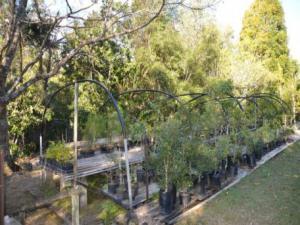 Kim’s stock-list reads like a Who’s Who of iconic subtropical rainforest trees: black booyong, flame tree, sassafras, tamarind, rosewood, yellow carabeen, Moreton Bay fig, plum pine, corkwood – the list goes on and on. There are lines of potted Red Cedars, a species logged into commercial extinction in the 1800’s. Along the driveway, wild cedar saplings spring up around a parent tree that Kim planted twenty years ago. Tree-ferns, stag-ferns and fish-bone ferns germinate naturally in pots and under walk ways. The place is bursting with life.
Kim’s stock-list reads like a Who’s Who of iconic subtropical rainforest trees: black booyong, flame tree, sassafras, tamarind, rosewood, yellow carabeen, Moreton Bay fig, plum pine, corkwood – the list goes on and on. There are lines of potted Red Cedars, a species logged into commercial extinction in the 1800’s. Along the driveway, wild cedar saplings spring up around a parent tree that Kim planted twenty years ago. Tree-ferns, stag-ferns and fish-bone ferns germinate naturally in pots and under walk ways. The place is bursting with life.
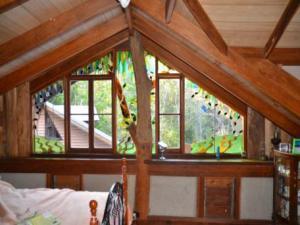 It’s not just the nursery and gardens that are impressive. Kim and Pete built their own character-laden mud-brick & stone home. Exposed beams and the extensive use of natural bush timber gives the house a delightful earthy feel. It seems to have risen organically from the hillside.
It’s not just the nursery and gardens that are impressive. Kim and Pete built their own character-laden mud-brick & stone home. Exposed beams and the extensive use of natural bush timber gives the house a delightful earthy feel. It seems to have risen organically from the hillside.
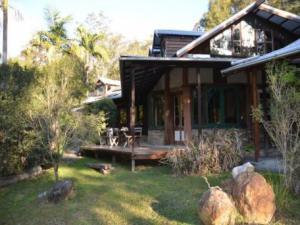 There is so much to see here! Rugged Tapin Tops National Park, high on the Great Eastern Escarpment. Legendary Ellenborough Falls, a horsetail waterfall on the Great Bulga Plateau with one of the longest single drops in the southern hemisphere. Or browse the stock at Tinonee Orchid Nursery, including a wide range of native orchids growing wild in the Manning Valley.
There is so much to see here! Rugged Tapin Tops National Park, high on the Great Eastern Escarpment. Legendary Ellenborough Falls, a horsetail waterfall on the Great Bulga Plateau with one of the longest single drops in the southern hemisphere. Or browse the stock at Tinonee Orchid Nursery, including a wide range of native orchids growing wild in the Manning Valley.
Exploring this magnificent region with Kim as my guide has been an amazing experience. I hope I can translate some of this beauty into words.

May 3, 2015
The Wingham Brush
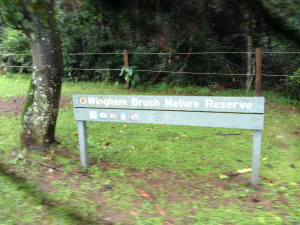 I’m on a trip to research my new novel, and am taking inspiration for its setting from Tapin Tops National Park north-east of Wingham in New South Wales. The park lies on a spectacular section of the Great Eastern Escarpment.
I’m on a trip to research my new novel, and am taking inspiration for its setting from Tapin Tops National Park north-east of Wingham in New South Wales. The park lies on a spectacular section of the Great Eastern Escarpment.
Ten hectare Wingham Brush Nature Reserve, just a short stroll from the centre of town, is a rare rainforest remnant. Along with five hectare Coocumbac Island at Taree, it represents 90% of the remaining subtropical lowland rainforest in the Manning Valley. This tiny oasis boasts 195 species of native plants and 100 species of native birds. The most impressive trees in  the reserve are the massive Moreton Bay figs, many centuries old. They are a type of strangler fig, and begin as a tiny seed, deposited in the fork of a host tree by birds or bats. The seedling lives as an epiphyte until its roots reach the ground. It then enlarges and strangles its host, eventually becoming freestanding. Like all figs, it has a unique relationship with wasps; figs are only pollinated by fig wasps, and fig wasps can only reproduce in fig flowers. Massive buttress roots support the weight of the trees in the shallow rainforest soils. Other
the reserve are the massive Moreton Bay figs, many centuries old. They are a type of strangler fig, and begin as a tiny seed, deposited in the fork of a host tree by birds or bats. The seedling lives as an epiphyte until its roots reach the ground. It then enlarges and strangles its host, eventually becoming freestanding. Like all figs, it has a unique relationship with wasps; figs are only pollinated by fig wasps, and fig wasps can only reproduce in fig flowers. Massive buttress roots support the weight of the trees in the shallow rainforest soils. Other 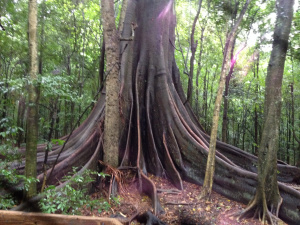 interesting trees include paperberries, black apples, white cedars and rosewoods. Giant stinging trees grow close to the path, so visitors must be wary.
interesting trees include paperberries, black apples, white cedars and rosewoods. Giant stinging trees grow close to the path, so visitors must be wary.
The Brush almost didn’t survive. By 1860 it had been selectively logged, especially for red cedar, and the remains of two saw pits can be seen today. It was saved from clear-felling in 1909, by being declared a reserve associated with the now historic wharf on the Manning River.
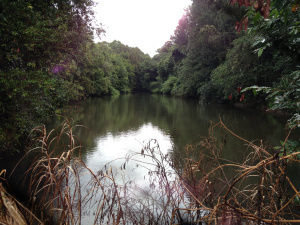
Manning River Inside Reserve
However by 1980 the Brush was so infested with weeds, that its very survival was threatened. Concerned locals commenced an innovative program to return the reserve to its natural state. The Wingham Brush Method has become an international model for rainforest restoration.
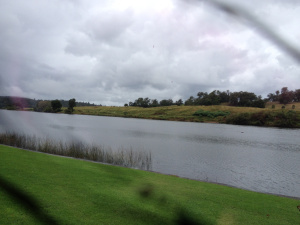
Manning River A Few Hundred Metres Clear Of Reserve
The Brush is an important maternity camp for vulnerable grey-headed flying foxes, and they can be seen roosting overhead. Wingham spent 70 years trying to kill off these fruit bats, before realising their importance. Flying foxes transport the seeds of a wide range of rainforest plants up to 40 km between camps, connecting isolated remnants to other rainforest gene pools.
Walking through Wingham Brush is like going back in time. Bittersweet, imagining the sheer majesty of these forests two hundred years ago, when they ranged from the coast all the way to edge of the Great Eastern Escarpment. What a magnificent sight that would have been!

April 26, 2015
Monty Roberts In Australia
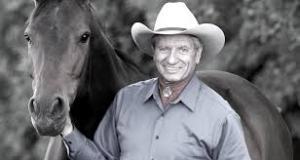 This weekend I was fortunate enough to attend a two-day horsemanship seminar at beautiful Boneo Park Equestrian Centre. It was conducted by the legendary Monty Roberts, aka The Man Who Listens To Horses. He’s a proponent of natural horsemanship, and I’ve been a fan of his forever. Of course natural horsemanship has also been around forever, at least for as long as humans and horses have been partners, about six thousand years. It’s a way of interacting with horses using minimum force, and designed not to stress or upset them. Unfortunately, it’s not the only way.
This weekend I was fortunate enough to attend a two-day horsemanship seminar at beautiful Boneo Park Equestrian Centre. It was conducted by the legendary Monty Roberts, aka The Man Who Listens To Horses. He’s a proponent of natural horsemanship, and I’ve been a fan of his forever. Of course natural horsemanship has also been around forever, at least for as long as humans and horses have been partners, about six thousand years. It’s a way of interacting with horses using minimum force, and designed not to stress or upset them. Unfortunately, it’s not the only way.
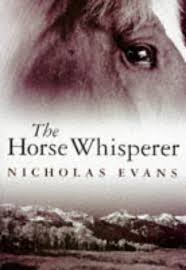 So eighty-year old Monty Roberts didn’t invent natural horsemanship, but he has been a decades-long proponent. He developed his particular method by watching wild mustangs interact with each other. He recognised a body language among the horses that was used to communicate and set boundaries. He found he could predictably read their fear, anger, irritation, relaxation and affection. Using this silent language allowed training in a more effective and humane manner, encouraging true partnership between horses and humans. Monty calls this language Equus. He inspired both the book and film The Horse Whisperer, and holds doctorates in human and animal behavioural psychology. By personal request of Queen Elizabeth, he trained the palace horses and has since spread his non-violent training techniques all over the world.
So eighty-year old Monty Roberts didn’t invent natural horsemanship, but he has been a decades-long proponent. He developed his particular method by watching wild mustangs interact with each other. He recognised a body language among the horses that was used to communicate and set boundaries. He found he could predictably read their fear, anger, irritation, relaxation and affection. Using this silent language allowed training in a more effective and humane manner, encouraging true partnership between horses and humans. Monty calls this language Equus. He inspired both the book and film The Horse Whisperer, and holds doctorates in human and animal behavioural psychology. By personal request of Queen Elizabeth, he trained the palace horses and has since spread his non-violent training techniques all over the world.
 Monty Roberts is also an author. His first book, The Man Who Listens to Horses spent fifty-eight weeks on the New York Times Bestsellers list. It was translated into fifteen languages and sold more than five million copies worldwide, His other books include the best-selling Shy Boy: The Horse That Came in from the Wild, Horse Sense for People, From My Hands to Yours, The Horses in My Life and Ask Monty. Oh, and did I mention that he and his wife of fifty-eight years have also fostered forty-seven children :)
Monty Roberts is also an author. His first book, The Man Who Listens to Horses spent fifty-eight weeks on the New York Times Bestsellers list. It was translated into fifteen languages and sold more than five million copies worldwide, His other books include the best-selling Shy Boy: The Horse That Came in from the Wild, Horse Sense for People, From My Hands to Yours, The Horses in My Life and Ask Monty. Oh, and did I mention that he and his wife of fifty-eight years have also fostered forty-seven children :)
 I was curious to see the man in action, and was not disappointed. Monty performed his signature ‘join up’ liberty technique, a round yard trust exercise, with over a dozen very different horses that he’d never met before. It was astonishing how predictably each animal reacted: cocking an ear towards him, narrowing the circle, licking its lips and finally bowing its
I was curious to see the man in action, and was not disappointed. Monty performed his signature ‘join up’ liberty technique, a round yard trust exercise, with over a dozen very different horses that he’d never met before. It was astonishing how predictably each animal reacted: cocking an ear towards him, narrowing the circle, licking its lips and finally bowing its 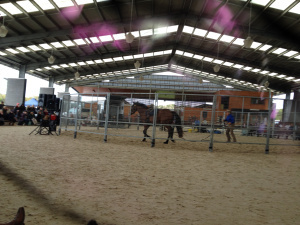 head. At this point the horse sought out Monty and reliably followed him – joining the herd. This was the precursor to some pretty amazing things. Youngsters calmly saddled and ridden for the first time, within the space of half an hour (four of them!) Dangerously spooky horses willingly following Monty over ground tarpaulins and past scary objects without lead ropes. Notoriously difficult loaders nonchalantly entering floats. This was truly impressive. One horse had taken four people and five hours to load it the previous day. Monty had it trotting, yes trotting, into the float of its own accord within fifteen minutes. More importantly, its young owner then replicated this success.
head. At this point the horse sought out Monty and reliably followed him – joining the herd. This was the precursor to some pretty amazing things. Youngsters calmly saddled and ridden for the first time, within the space of half an hour (four of them!) Dangerously spooky horses willingly following Monty over ground tarpaulins and past scary objects without lead ropes. Notoriously difficult loaders nonchalantly entering floats. This was truly impressive. One horse had taken four people and five hours to load it the previous day. Monty had it trotting, yes trotting, into the float of its own accord within fifteen minutes. More importantly, its young owner then replicated this success.
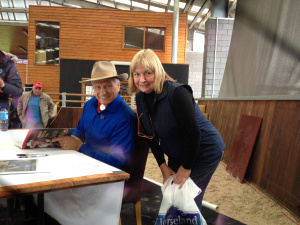 And Monty Roberts, at eighty years old, did all of his own horse-handling. I’d expected him to delegate much of the teaching. He was most generous with his time, answering questions and giving me some wonderful advice on a training issue I’m having with one of my mares. I’m convinced! He seems to be on an urgent mission to make the world a better place for both humans and horses. That is a wonderful thing!
And Monty Roberts, at eighty years old, did all of his own horse-handling. I’d expected him to delegate much of the teaching. He was most generous with his time, answering questions and giving me some wonderful advice on a training issue I’m having with one of my mares. I’m convinced! He seems to be on an urgent mission to make the world a better place for both humans and horses. That is a wonderful thing!
‘For centuries, humans have said to horses, ‘You do what I tell you or I’ll hurt you.’ Humans still say that to each other — still threaten, force and intimidate. I’m convinced that my discoveries with horses have value in the workplace, in the educational and penal systems, and in the raising of children. At heart, I’m saying that no one else has the right to say ‘you must’ to an animal — or to another human.’ Monty Roberts

April 18, 2015
Sunday Sermon
 I’m not religiously minded, not at all, which is probably a bit of a disappointment for my brother Rod, who is the Uniting Church minister for beautiful Phillip Island in Victoria. He has his own manse and everything, with a pretty church right in the backyard. He is also an aspiring author of young adult fantasy. I may be no church-goer, but I’m a great admirer of witty and/or unusual perspectives on ordinary things. So when Rod told me about a recent sermon he gave, (yes he actually gave this sermon!) I just had to share part of it. What writer could resist this editorial take on an excerpt from the Gospel of Mark! :)
I’m not religiously minded, not at all, which is probably a bit of a disappointment for my brother Rod, who is the Uniting Church minister for beautiful Phillip Island in Victoria. He has his own manse and everything, with a pretty church right in the backyard. He is also an aspiring author of young adult fantasy. I may be no church-goer, but I’m a great admirer of witty and/or unusual perspectives on ordinary things. So when Rod told me about a recent sermon he gave, (yes he actually gave this sermon!) I just had to share part of it. What writer could resist this editorial take on an excerpt from the Gospel of Mark! :)
Mark 1:9-15 ‘In those days Jesus came from Nazareth of Galilee and was baptized by John in the Jordan. And just as he was coming up out of the water, he saw the heavens torn apart and the Spirit descending like a dove on him. And a voice came from heaven, ‘You are my Son, the Beloved; with you I am well pleased.’ And the Spirit immediately drove him out into the wilderness. He was in the wilderness for forty days, and he was tempted by Satan; and he was with the wild beasts; and the angels waited on him. Now after John was arrested, Jesus came to Galilee, proclaiming the good news of God …’
“In fewer than 150 words Mark covers Jesus baptism, the temptations and the beginning of his ministry. The baptism gets the most coverage, about 65 words – telling us about the descent of the Spirit.
I can imagine what Mark’s editor would have said.
‘Now Mark, it is important to jump into the action, especially with a fast-moving narrative like yours, but really, you have to bring your readers with you. Show not tell – not even much telling here. You’ve done all right with John – camel’s hair, wild locusts – that’s good, we get a sense of someone unique, fanatical even, calling for change – you could do more, still, it’s ok. But with Jesus, your main character – ‘In those days Jesus came from Nazareth of Galilee and was baptised by John in the Jordan.’ I mean, really. It’s lame.
What was he doing in Nazareth? Why did he go to John – I mean if he was as special is you imply in the rest of the story? Take us into the event – we have to be there. Was it hot? Were there crowds? Was the water muddy? What about a conversation, with someone in the crowd, or John? And that voice and vision – it gives a whole new meaning to ‘omniscient narrator’. Who heard it, who saw it? Describe the reaction of the crowd: amazement, fear. Bit of work there I think.
Now, the next part. Wilderness is good. From the deserts the prophets come. Grounding himself in God, people will get that. But, honestly, forty days blah, blah, blah – ‘and he was tempted by Satan.’ And he was tempted by Satan! My God, is that all you can say. Ultimate battle between good and evil – that’s what you’re writing about– ‘and he was tempted by Satan’. How was he tempted? What was it like for him? Did he nearly give in? That’s good, he almost fails – try that. We have to be there, we have to feel for ourselves what he was going through, the struggle, the turmoil. Lot of work there, but done right it could set up the whole story. Oh and get rid of the angels – we could all vanquish Satan if we had angels. The next bit, again it’s good that you don’t hit the reader over the head by explaining every little detail but perhaps a bit more wouldn’t hurt. I know you’re concerned about the word count. Honestly there’s nothing to worry about. Anyway have a think about what I’m suggesting. I’ll see you again in a couple of weeks … Ah, Matthew, come in.’ ”
Thanks Rod. ‘ … and get rid of the angels.’ I love it!

April 11, 2015
Launch Of ‘Turtle Reef’
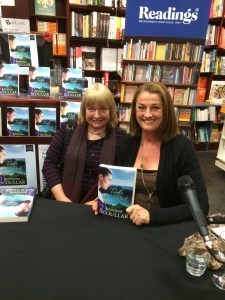
Kathryn Ledson (R) and me (L)
Last Wednesday was the official Melbourne launch of Turtle Reef at Readings Bookstore in Hawthorn, and afterwards at the Glenferrie Hotel. A great evening was had by all! For those of you who couldn’t come, here is a transcript of my Q&A session with the fabulous Kathryn Ledson, friend and fellow Penguin author.
Kath – Lawyer turned author – what happened?
Jen – This is a great lesson in following your passion. I never had a burning ambition to be a lawyer. I simply chose law because I had high enough marks to get into it – and it made my mother happy. The course was great. Studying law is excellent training in critical thinking, and it teaches intellectual discipline. But when it came to practising law, my heart wasn’t in it.
When I was a child, I did have a burning ambition though – to be a writer. Ten years ago I remembered that, and thank goodness I did. Finally I’m doing what I should be doing. In his wonderful essay ‘Why I write’, George Orwell says, ‘If a writer escapes from his early influences altogether, he will have killed his impulse to write.’ Well I didn’t escape from my early influences, and am very glad I went back to my roots.
Kath – Your fans must know how passionate you are about the environment. How did it come about? Has it always been a part of who you are or did a single incident get your attention to its plight?
Jen – A passion and love for the environment has always been a part of me. I think I never outgrew my childhood wonder with nature. Children are fascinated by caterpillars, and autumn leaves and ant nests. I still am. When people find out that I have animal characters in my stories, they often say ‘I didn’t know you wrote children’s books.’ This puzzles me. It’s as if for some reason we’re expected to outgrow our emotional connection with animals.
Kath – You write environmental or eco-romance. Do you think you’ve invented a sub-genre of the very popular “ru-ro”? Are you hoping more authors will join you in using fiction to highlight issues around the environment? (Or would you like them all to stay away :) )
Jen – It’s true that very few people are writing Australian rural fiction with environmental themes. But internationally, other authors are doing it, and very successfully at that. Take Barbara Kingsolver and her New York Times best-seller Flight Behaviour for example. She brilliantly weaves rural fiction with a climate-change theme, when the annual migration of millions of Monarch butterflies goes horribly wrong. So I’m already in very good company. I don’t know why more Australian authors aren’t writing adult fiction with animal characters and conservation themes. I think there should be more of it. Readers love these stories.
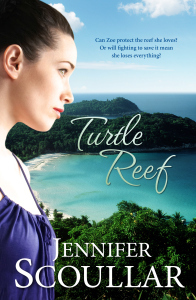 Kath –
TURTLE REEF
shines a light on some of the ever-present dangers to our Great Barrier Reef. Tell us about the story that shows this.
Kath –
TURTLE REEF
shines a light on some of the ever-present dangers to our Great Barrier Reef. Tell us about the story that shows this.
Jen – Well, simply put, Turtle Reef is the story of a love triangle between a farmer, a scientist and a coral reef. The main character, Zoe King is an unlucky-in-love zoologist who has sworn off men. She moves from Sydney to the Queensland sugar town of Kiawa, for a fresh start, and at first, it’s a dream come true, working at a marine centre, with the wildlife of beautiful Turtle Reef. But things quickly go wrong. First, she falls for Quinn, her boss’s boyfriend. Then, animals on the reef begin to sicken and die. Things aren’t exactly what they seem in picture-postcard perfect Kiawa. When her personal and professional worlds collide, she faces a terrible choice. Protecting the reef might mean betraying the man she loves.
Turtle Reef was inspired by my passion for the Great Barrier Reef, the largest coral ecosystem on our blue planet, and one of the seven natural wonders of the world. It holds a special place in my heart, and in the hearts of most Australians. I wanted to share my love of the Reef, and pay tribute to its unique wildlife. I wanted to showcase the important part it plays in the human and animal life of Queensland’s coastal communities. And I wanted to entertain readers with a passionate and unusual love story. If Turtle Reef sparks debate about reef protection, that’s a bonus.
Kath – Your character Zoe is a force to be reckoned with but I admit I was sceptical when I first started reading TURTLE REEF. Even though I know and trust your skills as a writer, I couldn’t see how you could pull off what clearly needed to be pulled off. Sydney girl arriving in a tight-knit rural environment, tackling age-old standards to save the reef. Taking on the very beautiful and talented local girl and falling in love with her childhood sweetheart! (What were you thinking!!) But you did pull it off – beautifully so – so, what is it, do you think, that makes Zoe’s journey such a riveting and believable one?
Jen – Zoe is simply a fabulous main character – She’s brave, intelligent, honest and passionate and was inspired by a real life ocean hero, Dr Eugenie Clark, known as the ‘Shark Lady’ who died last month and did her last dive at the age of 92. She was a pioneering marine biologist who dedicated her life to shark research, and defied social expectations about women’s roles in science. But Zoe is also a flawed heroine. She’s naïve, almost gullible at times. She wears her heart on her sleeve and is far too forthright for her own good. And although she’s a zoologist, her knowledge of animals is almost entirely theoretical. In fact she’s actually scared of horses and dolphins. Yet life in rural Queensland, and her job at the Reef Centre brings her in daily contact with these very animals. Throw in a crush on the boss’s boyfriend and a mystery out on the reef, and Zoe faces some serious challenges. That’s always interesting. We can all relate to somebody being thrown in the deep end, so to speak. Fortunately, Zoe’s pretty resourceful.
Kath – TURTLE REEF doesn’t just address issues around the reef. You clearly have a very special place in your heart for children and horses and love to write about them. There’s a beautiful bond that forms between a damaged boy and equally damaged horse. Without giving away too much, can you tell us a bit about it?
Jen – Ah, you’re talking about Josh, and Aisha, the Arabian mare. And you’re quite right, I do have a special love for children and horses. The healing effect that horses have on children is a favourite theme in my fiction. However that positive impact can work both ways. In Turtle Reef, Zoe befriends Josh, a teenage boy with an acquired brain injury. Josh might not have good people skills, but he’s very wise when it comes to animals, especially horses. He’s able to help the mare Aisha, as much as she helps him.
Kath – In TURTLE REEF I loved the character Einstein and learning about her very special attributes. Tell us about your eight-legged friend and the message she has for your readers.
Jen – I’m intrigued by Einstein as well. Einstein is an octopus. These misunderstood creatures are usually cast in such an evil light. Take the giant, murderous octopus from 20,000 Leagues Under The Sea, for example, or Ursula the sea witch from The Little Mermaid. I think the octopus gets such bad press because it is an alarmingly alien animal. Eight suckered arms. Three hearts pumping blue, copper-based blood around its boneless body. However, I’m a big fan. Jet-powered, master of camouflage, shape-shifter, and highly intelligent. And if people want to know about Einstein’s capacity for maternal self-sacrifice, they’ll have to read the book …
Kath – I always learn so much from reading your books. How much did you already know about the reef, its inhabitants, stuffy old rural farmers and their outdated methods? Was much research required and how did you conduct it?
Jen – Oh, you know me Kath. I’m such a nerd when it comes to these things, an amateur naturalist from way back. I actually did know quite a bit about the reef already. But Zoe is a marine zoologist after all, and I’m not. So last year I took a research trip to Bargara, on the southern tip of the Great Barrier Reef.
Zoe’s love interest Quinn Cooper is a fifth generation cane grower. I had a lot to learn about the joys and challenges of sugar farming. The cane trains were especially fascinating. Did you know that Queensland has 4,000 kilometres of narrow gauge track? And that these picturesque little locomotives still transport almost forty million tonnes of sugar cane to the mills each year? Breathing life into Zoe’s character was even more interesting. It involved some island hopping, some snorkelling on coral reefs, some whale-watching and sitting around on moonlit beaches with hatching turtles. It was a tough job, but someone had to do it!
Kath – Finally, you know so much about it all, but can you tell me this: if I punch a Tiger shark on the nose, will it go away?
Jen – It does sometime works. Sharks are reactive animals, big sooks really, and don’t like getting hurt any more than you or I do. Their noses are vulnerable because they bear organs called Ampulae of Loranzini which are used to detect slight water pressure changes like the movement of an injured fish flopping around. These organs are very sensitive and hopefully a good hit to the nose will work – or a jab in the eyes. Hope you never have to try it Kath!

April 4, 2015
Easter Sunday With Jenn J McLeod + Book Giveaway
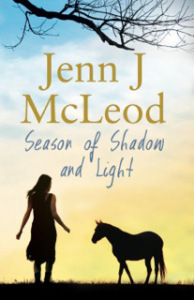 Please welcome author, friend and fellow animal nut, Jenn J McLeod, to Pilyara on this Easter Sunday. Her wonderful new novel, Season Of Shadow And Light, is coming out on May 1st. What a luminous cover! I was lucky enough to receive an advance copy and can tell you that readers are in for a real treat. Such a multi-layered, thought-provoking story about the best and worst of families, and it also features a horse! Over to you Jenn!
Please welcome author, friend and fellow animal nut, Jenn J McLeod, to Pilyara on this Easter Sunday. Her wonderful new novel, Season Of Shadow And Light, is coming out on May 1st. What a luminous cover! I was lucky enough to receive an advance copy and can tell you that readers are in for a real treat. Such a multi-layered, thought-provoking story about the best and worst of families, and it also features a horse! Over to you Jenn!
I was six the day a horse ate my buttons‘We share so much more than a great name, Jen. For a start, we both love animals—all animals—and we hate seeing them neglected and mistreated.
If I had to pick a favourite animal it would definitely be dogs. And I know you love dogs. But I REALLY, really, really love dogs. Every day when I wake up and my old (now blind) rescue baby is at the foot of the bed (staring and telling me to get up) I feel blessed and lucky to have her in my life, even though her vet bills are now slowly siphoning away my retirement savings!
I love dogs so much I wanted to feature one in a novel. So, the original Season of Shadow and Light plot featured a mangy mutt as the star of the story. That was until I started researching the world of animals as therapy and developed a fascination for the human/horse connection. Around the same time (coincidental or karma) I discovered a very personal horse-related project to test out a few theories—and it was almost next door to where I lived.
Looking at the final cover for Season of Shadow and Light, I hardly have to tell you that the horse theme, and not the mangy mutt, won in the end. My love of horses goes way back to when, as a young child, my Dad (a NSW Police Bandsman) would take me to the Sydney Royal Easter Show. He’d leave me in my special seat (ie in the horse float and hay stores area under the grandstand) to watch the NSW Police Band do a special performance called, The Musical Ride, in which the mounted police and the brass band would do a choreographed marching routine that weaved between the horses. When they finished several routines, the horses would return to the staging area while the band played on. It was all very thrilling—until the unthinkable happened.
One day a horse ate the buttons off my shirt! For some reason that incident traumatised me. I remember the moment as though it was yesterday—and as clearly as I remember the shirt that buttoned up at the back with little pearl buttons. After that incident, I still loved watching my Dad in The Musical Ride performance, and I still loved horses, but I couldn’t get up close to a horse any more. For years I was like a person who loves the beach but can’t be in the sun. In saying that, just as the might of the sea can still spellbind an observer, I remained awestruck by the magnificence of a horse.
I have since reconnected with horses and made a horse friend—all thanks to my research for Season of
Shadow and Light. Readers of Simmering Season might recall Maggie visiting an old horse that stood alone in a paddock in all weather—neglected, with no shelter, it’s blanket tatty and torn. There’s a bit of me in those scenes as it was a real horse that inspired that equine character. On my morning walk I would stop and chat to a lonely, neglected, nippy old horse being agisted on a nearby property. (Neighbourhood goss suggested the owner was not a local, nor a rider any more due to declining health.) Initially I called the horse, Ed (yes, the talking horse) and over a time (carrots helped) he let me get closer.
I’d like to think that horse and I helped each other. He certainly helped me. When we sold up to hit the road in our caravan I was so sad to leave Ed behind I decided to write him into Simmering Season. As it turns out, Ed was no ordinary horse either. He was (more neighbourhood goss) once a prize-winning race horse and while his real name was Nevaeh, to me he will always be Ed. (Oh, and by the time I left the area, other locals had taken on the morning, noon and night visits and treats.)
With trust and loyalty as the main theme throughout this novel I think it’s fitting that a horse be featured. Humans can learn a lot about both those qualities from horses (and from dogs). Animals put their trust in humans and I don’t think there’s anything sadder than a neglected animal. I do hope readers of Season of Shadow and Light will excuse my mini soapbox moment when I bang on about some animals being a life-long commitment, and with horses that life can be a very be long time. And look out for my tribute to Nevaeh.
With early reader reviews already in like this one “Jenn J McLeod is an author for all seasons . . . and all readers.” Shelleyrae, wwwbookdout.wordpress.com, I am super excited about this story of secrets and love, of family loyalty, and of trust—the kind that takes years to build but only seconds to wash away.
Cheers, Jen. I look forward to seeing you at my place soon for my #WriteRoundOz Author Series.’
 I can’t wait Jenn, and thanks for dropping by today! Readers, for your chance to WIN all THREE Jenn J McLeod novels* simply leave a comment below. From now until the end of May, Jenn drops into some of her favourite author blogs to say hello to readers old and new. She’ll then collect the comment names from each author blog post, picking a lucky winner from one major draw and announcing the name at the end May of on her blog
I can’t wait Jenn, and thanks for dropping by today! Readers, for your chance to WIN all THREE Jenn J McLeod novels* simply leave a comment below. From now until the end of May, Jenn drops into some of her favourite author blogs to say hello to readers old and new. She’ll then collect the comment names from each author blog post, picking a lucky winner from one major draw and announcing the name at the end May of on her blog
If you’d like to find out more about Jenn and her contemporary women’s fiction about small towns keeping big secrets, head on over to her website or, like me, follow the Facebook and Twitter fun.
Website: www.jennjmcleod.com
Facebook: https://www.facebook.com/JennJMcLeod.Author
Twitter: @jennjmcleod
*Book Pack: House for all Seasons (#5 Top Selling Debut novel, 2013), Simmering Season, and Season of Shadow and Light. (Australian postal address only)
And now to announce the winners in my Turtle Reef prize draw! So many books to giveaway today :). Congratulations to Karla Oleinikoff and Kim Foster. I’ll email you soon for your postal address. Many thanks to all who left comments.

March 21, 2015
‘Turtle Reef’ Release and Giveaway!
 Well, it’s that time of year again, when I give my blog over to shameless self-promotion! My latest novel, Turtle Reef, will be released by Penguin on the 25th March. The official Melbourne launch will be at Readings Bookstore, 701 Glenferrie Rd, Hawthorn on Wednesday 8th April at 6.00pm. Free event. All welcome!
Well, it’s that time of year again, when I give my blog over to shameless self-promotion! My latest novel, Turtle Reef, will be released by Penguin on the 25th March. The official Melbourne launch will be at Readings Bookstore, 701 Glenferrie Rd, Hawthorn on Wednesday 8th April at 6.00pm. Free event. All welcome!
To celebrate, I’m giving away two copies of Turtle Reef. (Aust & NZ residents only) To go in the draw, just leave a comment on this post. Winners announced on Sunday 5th April.
This week I’m posting a Q&A I did for Penguin Australia.
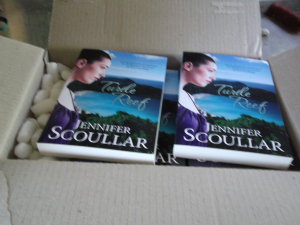
Box of Turtle Reef author copies. Exciting!
What is your new book about?
Turtle Reef is the story of Zoe King, an unlucky-in-love zoologist who has given up on men. Moving from Sydney to take up an exciting new role in marine science in the small sugar town of Kiawa is a welcome fresh start.
Zoe is immediately charmed by the region’s beauty – by its rivers and rainforests, and by its vast cane fields, sweeping from the foothills down to the rocky coral coast. And also by its people – its farmers and fishermen, unhurried and down to earth, proud of their traditions.
Her work at the Reef Centre provides all the passion she needs and Zoe finds a friend in Bridget, the centre’s director. The last thing she wants is to fall for her boss’s boyfriend, cane king Quinn Cooper, and so she refuses to acknowledge the attraction between them – even to herself.
But things aren’t quite adding up at the Reef Centre and when animals on the reef begin to sicken and die, Zoe’s personal and professional worlds collide. She faces a terrible choice. Will protecting the reef mean betraying the man she loves?
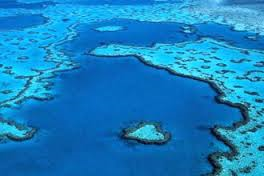 What or who inspired it?
What or who inspired it?
- Turtle Reef was inspired by my passion for the Great Barrier Reef, the largest coral ecosystem on our blue planet, and one of the seven natural wonders of the world. It holds a special place in the hearts of Australians . I wanted my story to show the important part the reef plays in the human and animal life of coastal communities. It was also an excuse to write about dugongs and dolphins!
What was the biggest challenge, writing it?
- The biggest challenge was not letting the animals hijack the story. They wanted to hog the plot!
What did you want to achieve with your book?
- I wanted to share my love of the Great Barrier Reef, and pay tribute to its unique wildlife. I also wanted to entertain readers with a passionate and unusual love story. If Turtle Reef sparks debate about reef protection, that’s a bonus.
Are there any parts of it that have special personal significance to you?
- The story of the black Arabian mare, Aisha, is loosely based on the life of my own mare, Starfire. And like Zoe King, I’ve always been fascinated by marine mammals.
What do you see as the major themes in your book?
- The main themes in Turtle Reef are: change versus tradition, the risks and rewards of freedom and learning to challenge your fears. The book also explores our relationship with animals and nature.
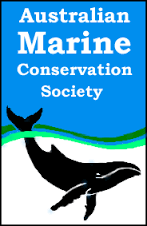 To whom have you dedicated the book and why?
To whom have you dedicated the book and why?- Turtle Reef is dedicated to the Australian Marine Conservation Society. They provide Australia’s ocean wildlife with a vital voice.
Who do you think will enjoy your book?
- Anybody who likes horses, dolphins, or ripping yarns in magnificent settings.
Describe yourself in three words?
- Passionate, compassionate and nerdy
What three things do you dislike?
– Cruelty, indifference and greed
What three things do you like?
- Horses, the wilderness and champagne.
What would you like to think people can get from reading your book?
- I hope Turtle Reef can transport readers to the southern tip of the Great Barrier Reef, and immerse them in the lives of its unique people and wildlife.
What do you think your life will be like 20 years from now?
- Not very different from today I hope – riding horses and writing books.
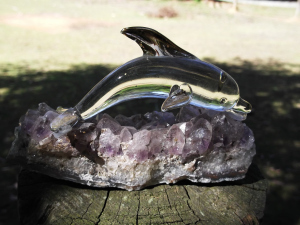 What would you say is your interesting writing quirk?
What would you say is your interesting writing quirk?- I always have a special good-luck symbol for each book I write. For Billabong Bend it was an unused bird-shot cartridge. For Turtle Reef it was a crystal dolphin on a piece of amethyst that my brother gave me.
Where do you get your information or ideas for your books
- Mainly from my own imagination, although I always undertake research trips to ensure settings are authentic. Google and the State Library also get a good workout.
As a child, what did you want to do when you grew up?
- Write books and ride horses.
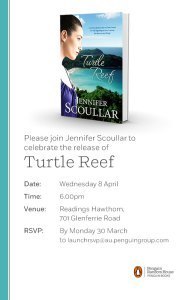 If you were for sale the ad would say…
If you were for sale the ad would say…- ‘Well-bred aged mare. Nice nature. No vices (well, hardly any!) Quick on feet and loves bush riding. Can be stubborn. Needs experienced rider.’
What is your life motto?
- ‘If at first you don’t succeed, try and try again.’
What is your most memorable moment?
- Apart from when my children were born, you mean? Getting published for the first time of course.

March 15, 2015
Foreshadowing
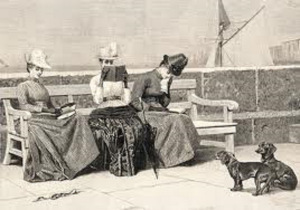 It’s the time of the month for some writerly discussion on craft. Today, author and writing mentor Sydney Smith and I discuss the literary technique of foreshadowing.
It’s the time of the month for some writerly discussion on craft. Today, author and writing mentor Sydney Smith and I discuss the literary technique of foreshadowing.
SYDNEY:
Foreshadowing is the seeding of minor precursors to some greater event in a story. This is how believability is created. If you want the reader to believe an event in your story that might not seem altogether credible, foreshadow it and the reader will believe it. Even if the major event is already believable, foreshadowing will draw the reader in and make it even more convincing.
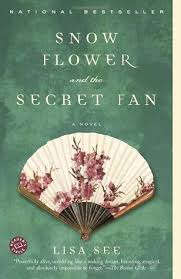 For example, Snow Flower and the Secret Fan is set in Old China, where every aspect of life is arranged according to strict rules and customs. The narrator, Lily, has a special friendship with Snow Flower, one that was arranged especially to improve Lily’s marriage prospects. In fact, this friendship is dearer to Lily than the wealthy marriage she enters into as a girl of seventeen. But at the climax of the story, Lily humiliates Snow Flower out of jealous vengeance, and she loses the one relationship in her life that matters more to her than any other. Without foreshadowing, this climax might have been unbelievable, since Lily loves Snow Flower. Why would she do such a thing to the woman who matters most to her? Lisa See foreshadows it in a confrontation between Lily and her mother, one that reveals her vengeful spirit. She acts spitefully in this confrontation, and thus, her greater spitefulness in humiliating Snow Flower in the climax is foreshadowed. We have seen her behave vengefully once before. So at the climax, when the story needs us to believe it without question, we do thanks to foreshadowing.
For example, Snow Flower and the Secret Fan is set in Old China, where every aspect of life is arranged according to strict rules and customs. The narrator, Lily, has a special friendship with Snow Flower, one that was arranged especially to improve Lily’s marriage prospects. In fact, this friendship is dearer to Lily than the wealthy marriage she enters into as a girl of seventeen. But at the climax of the story, Lily humiliates Snow Flower out of jealous vengeance, and she loses the one relationship in her life that matters more to her than any other. Without foreshadowing, this climax might have been unbelievable, since Lily loves Snow Flower. Why would she do such a thing to the woman who matters most to her? Lisa See foreshadows it in a confrontation between Lily and her mother, one that reveals her vengeful spirit. She acts spitefully in this confrontation, and thus, her greater spitefulness in humiliating Snow Flower in the climax is foreshadowed. We have seen her behave vengefully once before. So at the climax, when the story needs us to believe it without question, we do thanks to foreshadowing.
JENNY: I see foreshadowing as a two-part affair―first the hint (or hints), then the payoff. If a jewellery store is to be robbed, there might be a suspicious customer in the day before. If a man is to leave his wife, he might be reluctant to make holiday plans. Keeping the hint and payoff firmly linked in my mind, will make the setup more straightforward. Sometimes I write myself notes about it. And the more significant the payoff event, the earlier I like to plant hints.
I see foreshadowing as a two-part affair―first the hint (or hints), then the payoff. If a jewellery store is to be robbed, there might be a suspicious customer in the day before. If a man is to leave his wife, he might be reluctant to make holiday plans. Keeping the hint and payoff firmly linked in my mind, will make the setup more straightforward. Sometimes I write myself notes about it. And the more significant the payoff event, the earlier I like to plant hints.
As a reader, I always love when crucial events are deftly foreshadowed. That Ahh, I get it! moment is immensely satisfying. The classics are full of them. In John Steinbeck’s Of Mice And Men, the killing of Candy’s old dog hints at the later killing of Lennie. In Macbeth, Shakespeare uses the witches and their prophecies to foreshadow events. They warn that ‘fair is foul and foul is fair’. In Romeo and Juliet, Juliet complains to her nurse ‘My grave is like to be my wedding-bed.’ And in the wonderful Charlotte’s Web, Charlotte the spider explains to Wilbur that all living things eventually die. This foreshadows the main plot conflict, which is saving Wilbur from the slaughterhouse. Charlotte weaves a web over the barn door with a message that startles the humans into sparing Wilbur’s life. In the process of spinning her web, Charlotte expends all her energy and dies, just as she had hinted to Wilbur at the beginning of the story.
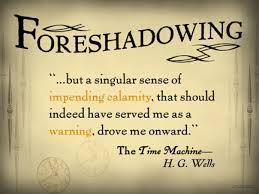 I will often read a novel containing clever foreshadowing a second time, in order to fully appreciate the author’s skill. But as a writer, I find it a fine line to tread. Too blatant a hint might give the game away. Too subtle, and readers might not make the connection at all. These days I err on the side of subtle. Readers are clever and sophisticated creatures! Sometimes writers forget this.
I will often read a novel containing clever foreshadowing a second time, in order to fully appreciate the author’s skill. But as a writer, I find it a fine line to tread. Too blatant a hint might give the game away. Too subtle, and readers might not make the connection at all. These days I err on the side of subtle. Readers are clever and sophisticated creatures! Sometimes writers forget this.
Of course the wonderful thing about foreshadowing is that you don’t have to get it right the first time. It’s rare to nail it in a first draft. I’ve often gone back through a manuscript and added clues. That’s when a good chapter summary document – a road map – comes into its own. Sometimes too, my editor suggests I either tone down or ramp up the foreshadowing. It takes a lot of practice.
SYDNEY: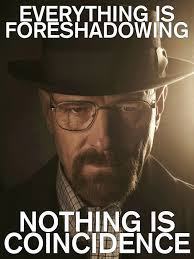 The funny thing about foreshadowing is that if done well, it happens all the way through. EVERYTHING is foreshadowed. You realise this if you study closely the favourite novels that you read again and again. I’ve been studying Snow Flower with one of my students and we keep stumbling across instances of foreshadowing. It becomes the cement that glues a narrative together. It makes the story stronger, more solid. It putties in the gaps.
The funny thing about foreshadowing is that if done well, it happens all the way through. EVERYTHING is foreshadowed. You realise this if you study closely the favourite novels that you read again and again. I’ve been studying Snow Flower with one of my students and we keep stumbling across instances of foreshadowing. It becomes the cement that glues a narrative together. It makes the story stronger, more solid. It putties in the gaps.
Foreshadowing is not to be confused with predictability, though. Predictability arises out of clichéd characters who act in clichéd ways. Foreshadowing is the trail of breadcrumbs you follow, not realising they’re breadcrumbs. You think the forest is thick with trees, that the way stumbles right and left. But in fact there is a path, and that path is foreshadowing.

March 7, 2015
Tribute To The ‘Shark Lady’ on International Women’s Day
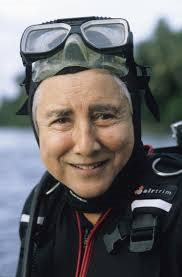 Today is International Women’s Day – the perfect time to celebrate the contribution women make to conservation around the world. In keeping with the theme of my upcoming release, Turtle Reef, I’m celebrating the life of an ocean hero. Dr Eugenie Clark inspired the character of zoologist Zoe King in my upcoming release.This wonderful woman, who died last week at 92, was an author and pioneering marine biologist known as the ‘Shark Lady’. She dedicated her life to shark research, while defying social expectations about women’s roles in science. When you see a shark underwater, you should say ‘How lucky I am to see this beautiful animal in its environment.’ Comments like this helped dispel widely held fears of this misunderstood predator.
Today is International Women’s Day – the perfect time to celebrate the contribution women make to conservation around the world. In keeping with the theme of my upcoming release, Turtle Reef, I’m celebrating the life of an ocean hero. Dr Eugenie Clark inspired the character of zoologist Zoe King in my upcoming release.This wonderful woman, who died last week at 92, was an author and pioneering marine biologist known as the ‘Shark Lady’. She dedicated her life to shark research, while defying social expectations about women’s roles in science. When you see a shark underwater, you should say ‘How lucky I am to see this beautiful animal in its environment.’ Comments like this helped dispel widely held fears of this misunderstood predator.
During expeditions around the world since the 1940’s, Eugenie pioneered scuba diving for gathering scientific data and making observations. She beat Jacques Cousteau to the punch by several years. ‘Her work in Egypt prompted some of the world’s first shark 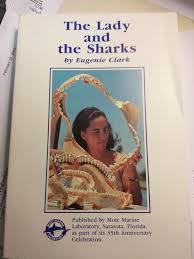 protection policies,’ says Ania Budziak, Project AWARE Program Director. ‘That legacy lives on as Egypt emerges as a leading proponent of international shark safeguards, championed by people who still cherish their memories of working with Eugenie Clark long ago.‘ Dr Clark was also a pioneer in communicating her scientific work to the public. She shared the adventures and excitement of her research through lectures, television specials, and articles in popular magazines like National Geographic and Science Digest. She wrote three best-selling books: Lady with a Spear (1951),The Lady and the Sharks (1969) and The Desert Beneath the Sea (1991), a children’s book about a scientist researching the sandy bottom of the sea.
protection policies,’ says Ania Budziak, Project AWARE Program Director. ‘That legacy lives on as Egypt emerges as a leading proponent of international shark safeguards, championed by people who still cherish their memories of working with Eugenie Clark long ago.‘ Dr Clark was also a pioneer in communicating her scientific work to the public. She shared the adventures and excitement of her research through lectures, television specials, and articles in popular magazines like National Geographic and Science Digest. She wrote three best-selling books: Lady with a Spear (1951),The Lady and the Sharks (1969) and The Desert Beneath the Sea (1991), a children’s book about a scientist researching the sandy bottom of the sea.
 In 1955 she founded the Mote Marine Laboratory in Florida. This has grown into a major centre for shark, dolphin, dugong and sea turtle research. It’s educated countless visitors and launched careers in shark science and conservation. Sonja Fordham, President of Shark Advocates International, says, ‘Mote has certainly changed the course of my career by serving as a forum for ground-breaking discussion and collaboration on shark research and conservation.’
In 1955 she founded the Mote Marine Laboratory in Florida. This has grown into a major centre for shark, dolphin, dugong and sea turtle research. It’s educated countless visitors and launched careers in shark science and conservation. Sonja Fordham, President of Shark Advocates International, says, ‘Mote has certainly changed the course of my career by serving as a forum for ground-breaking discussion and collaboration on shark research and conservation.’
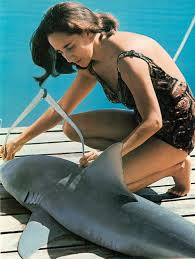 Eugenie Clark never lost her passion for diving, making her last dive on her 92nd birthday in the Red Sea. She continued lecturing up to the last few months of her life.She inspired thousands of young women to follow her footsteps, and raised the profile of marine conservation forever. In a world where girls often shy away from science at school, we need more ground breaking women researchers. Dr Eugenie Clark, on this International Women’s Day, I honour you.
Eugenie Clark never lost her passion for diving, making her last dive on her 92nd birthday in the Red Sea. She continued lecturing up to the last few months of her life.She inspired thousands of young women to follow her footsteps, and raised the profile of marine conservation forever. In a world where girls often shy away from science at school, we need more ground breaking women researchers. Dr Eugenie Clark, on this International Women’s Day, I honour you.





